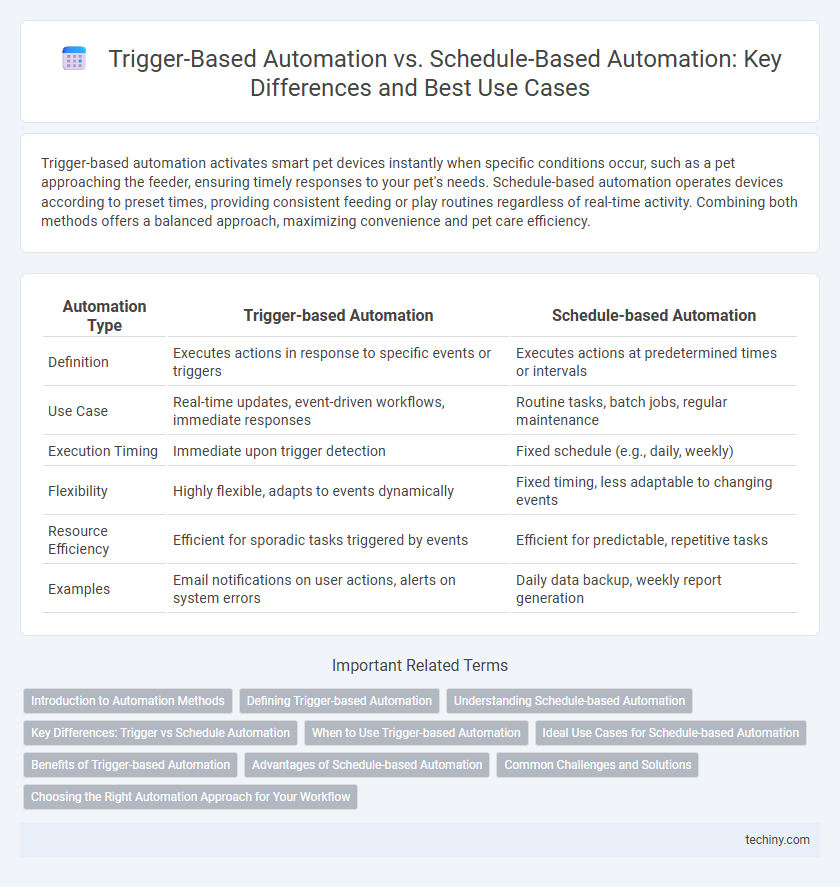Trigger-based automation activates smart pet devices instantly when specific conditions occur, such as a pet approaching the feeder, ensuring timely responses to your pet's needs. Schedule-based automation operates devices according to preset times, providing consistent feeding or play routines regardless of real-time activity. Combining both methods offers a balanced approach, maximizing convenience and pet care efficiency.
Table of Comparison
| Automation Type | Trigger-based Automation | Schedule-based Automation |
|---|---|---|
| Definition | Executes actions in response to specific events or triggers | Executes actions at predetermined times or intervals |
| Use Case | Real-time updates, event-driven workflows, immediate responses | Routine tasks, batch jobs, regular maintenance |
| Execution Timing | Immediate upon trigger detection | Fixed schedule (e.g., daily, weekly) |
| Flexibility | Highly flexible, adapts to events dynamically | Fixed timing, less adaptable to changing events |
| Resource Efficiency | Efficient for sporadic tasks triggered by events | Efficient for predictable, repetitive tasks |
| Examples | Email notifications on user actions, alerts on system errors | Daily data backup, weekly report generation |
Introduction to Automation Methods
Trigger-based automation activates specific tasks instantly when predefined events occur, enabling real-time responsiveness and dynamic workflow adjustments. Schedule-based automation executes tasks at predetermined times or intervals, ensuring consistent and routine operations without manual intervention. Both methods enhance efficiency by reducing manual effort but differ in their application depending on the need for immediacy or regularity.
Defining Trigger-based Automation
Trigger-based automation activates workflows instantly when specific events or conditions occur, such as a user action, system alert, or data change, enabling real-time responsiveness and dynamic process management. This type of automation relies on event-driven architecture and webhook integrations to monitor defined triggers and execute tasks without manual intervention. By eliminating delays, trigger-based automation enhances operational efficiency, accuracy, and customer experience through immediate execution of predefined actions.
Understanding Schedule-based Automation
Schedule-based automation relies on predefined timings to execute tasks automatically, ensuring consistent and timely operations without manual intervention. It optimizes workflows by running processes at specific intervals, such as daily backups or weekly report generation, enhancing efficiency and reliability. This approach reduces the risk of human error and allows businesses to allocate resources more effectively by automating routine activities based on fixed schedules.
Key Differences: Trigger vs Schedule Automation
Trigger-based automation initiates actions immediately in response to specific events or conditions, ensuring real-time responsiveness and dynamic workflow adjustments. Schedule-based automation operates on predefined time intervals or dates, enabling routine tasks and batch processes to run consistently without manual intervention. The key difference lies in trigger automation's event-driven execution versus schedule automation's time-driven execution, impacting flexibility and use case suitability.
When to Use Trigger-based Automation
Trigger-based automation is ideal for real-time responses that require immediate action upon specific events, such as user interactions, system alerts, or data changes. It enhances operational efficiency by initiating workflows precisely when conditions are met, reducing delays and manual intervention. This approach is crucial in dynamic environments like marketing campaigns, IT incident management, and personalized customer experiences.
Ideal Use Cases for Schedule-based Automation
Schedule-based automation is ideal for repetitive tasks occurring at fixed intervals, such as daily data backups, system maintenance, or routine report generation. It excels in environments requiring consistent execution times without human intervention, ensuring reliability and efficiency. Businesses leveraging consistent workflows benefit from reduced operational errors and enhanced productivity through time-specific automation.
Benefits of Trigger-based Automation
Trigger-based automation enhances operational efficiency by initiating tasks instantly in response to specific events or conditions, reducing delays and manual intervention. It enables real-time responsiveness, improving accuracy and ensuring that workflows adapt dynamically to changing inputs or system states. This automation method supports scalable, event-driven systems that optimize resource use and increase productivity across various applications.
Advantages of Schedule-based Automation
Schedule-based automation ensures consistent and timely execution of tasks, reducing the risk of human error and increasing operational efficiency. This method allows businesses to plan routine processes during off-peak hours, optimizing resource utilization and minimizing system downtime. It supports scalability by automating repetitive workflows, freeing up human resources for more strategic activities.
Common Challenges and Solutions
Trigger-based automation often faces challenges related to event latency and false positives, which can disrupt workflow consistency, while schedule-based automation struggles with rigid timing that may not align with dynamic operational demands. Implementing real-time monitoring systems and adaptive scheduling algorithms can mitigate latency and improve responsiveness in trigger-based automation. For schedule-based automation, incorporating flexibility through predictive analytics and exception handling mechanisms ensures tasks run optimally despite changing conditions.
Choosing the Right Automation Approach for Your Workflow
Trigger-based automation instantly initiates tasks based on specific events or conditions, enabling real-time responses and enhancing operational efficiency in dynamic workflows. Schedule-based automation executes tasks at predetermined times or intervals, ensuring consistent performance and reliability for routine processes. Selecting the appropriate automation approach depends on the workflow's nature; trigger-based suits event-driven tasks requiring immediacy, while schedule-based fits repetitive, time-sensitive operations needing regular execution.
Trigger-based Automation vs Schedule-based Automation Infographic

 techiny.com
techiny.com